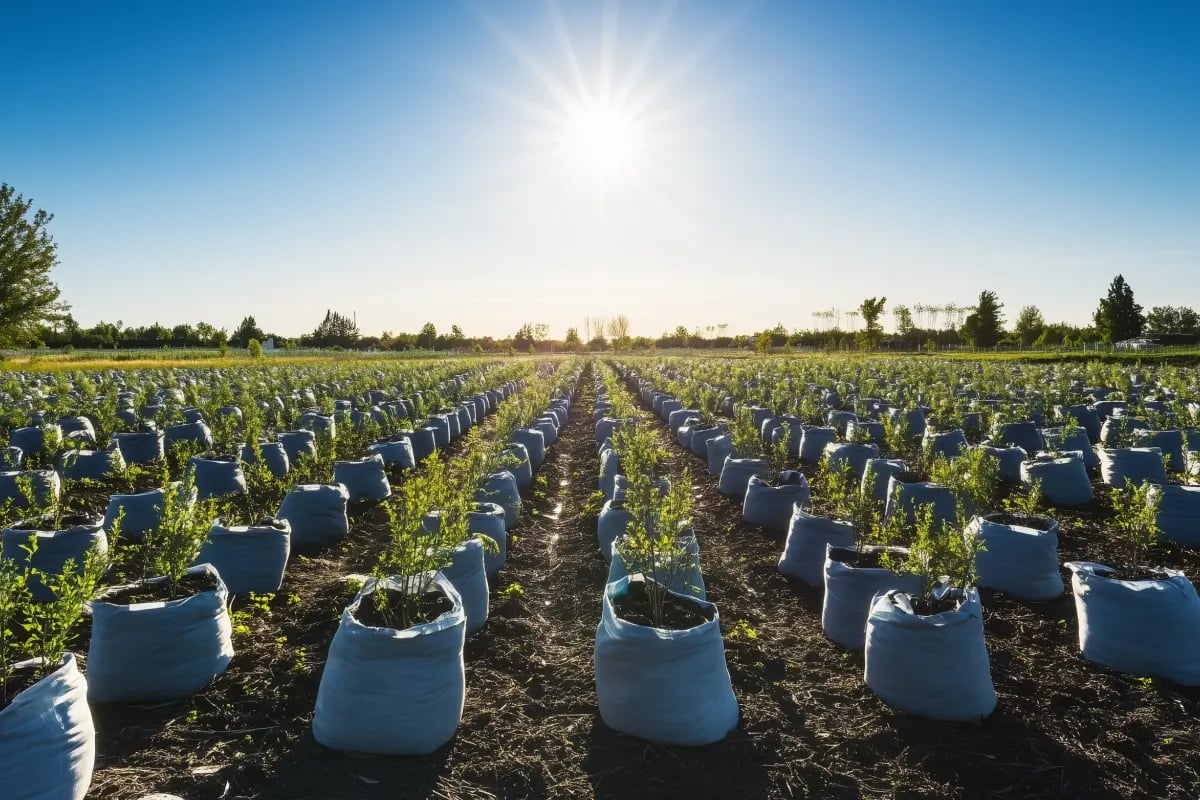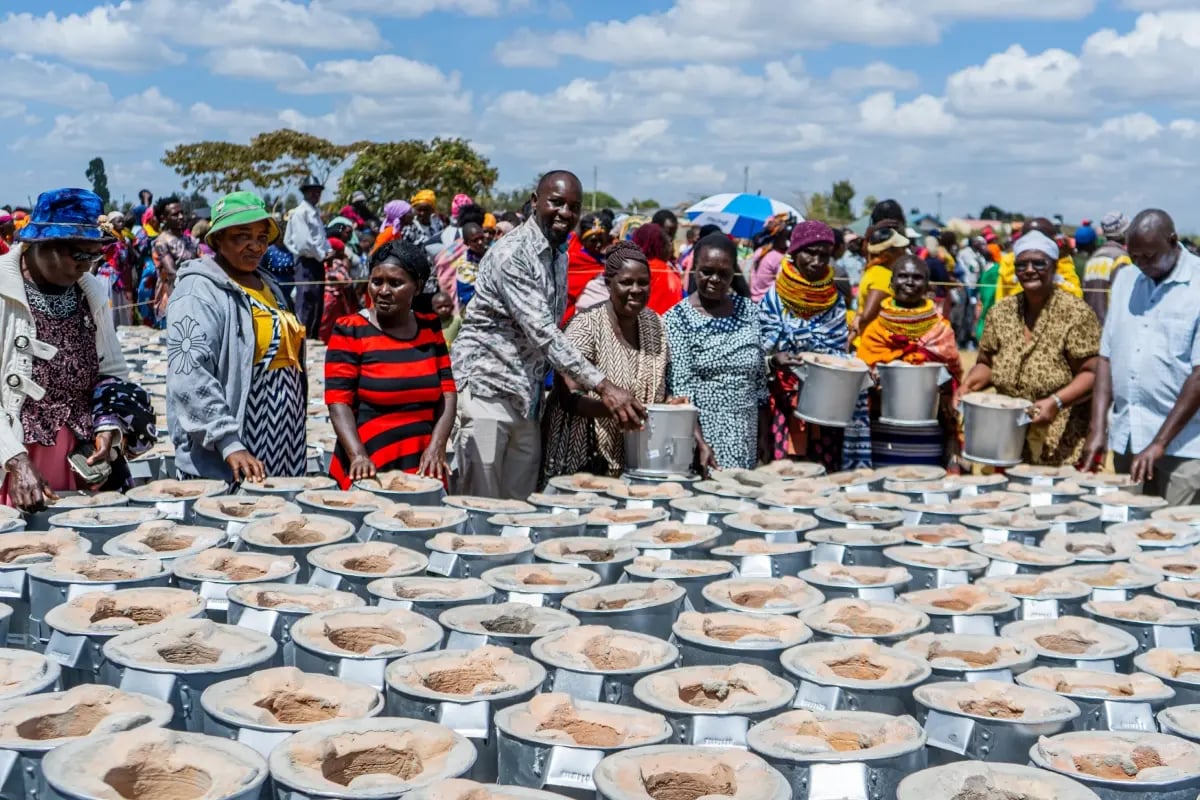African Agriculture Holdings, a US-based agribusiness listed on Nasdaq, has laid out ambitious...
The Carbon Unit Market: A 2025 Overview
As 2025 begins, the carbon credit market stands at an important milestone. Over the past year, the voluntary carbon market demonstrated its resilience, balancing investor expectations, regulatory developments, and innovation in unit quality and methodology. With global retirements reaching approximately 176 million carbon units for 2024, the sector maintained stable performance while laying the groundwork for more scalable, credible mechanisms for environmental initiatives.
 Tree seedlings ready for planting, arranged in rows. AI generated picture.
Tree seedlings ready for planting, arranged in rows. AI generated picture.
Registries are diversifying, buyers are becoming more discerning, and investment is rising in both nature-based solutions and high-durability carbon removals. At the same time, ambitious regulatory frameworks such as the EU's CSRD are catalysing demand for traceable, high-integrity units. These developments signal not a plateau, but a recalibration—one that positions the market for strong, sustainable growth in the decade ahead.
Consolidation and Confidence
2024 marked a period of consolidation that reinforced confidence in the voluntary carbon market’s long-term trajectory. The year closed with steady retirement volumes—176 million credits, an increase from 2023 that reflects growing corporate nature engagement and ongoing reliance on carbon markets to meet sustainability targets.
Importantly, buyers showed a clear preference for quality. Projects rated highly on transparency, durability, and co-benefits increasingly attracted premium pricing. For example, ARR credits rated A were trading above $40 per tonne, compared to roughly $10 for C-rated equivalents, underscoring the market’s maturing understanding of what constitutes true impact.
 Graph showing ARR credit spot prices (for projects with price quotes in L12M).
Graph showing ARR credit spot prices (for projects with price quotes in L12M).
In terms of supply, established registries such as Verra continued to play a leading role, but newer platforms—including Gold Standard, Puro.earth, and Isometric—expanded their footprint with innovative methodologies and transparent verification practices. Verra still accounted for 63% of all retirements, yet its issuance share declined to 36% (from 45% in 2023), reflecting healthy competition and diversification.
The durable carbon removal segment, while still emerging, made significant strides. Though accounting for only 0.11% of total retirements, this category is poised for growth, buoyed by robust pre-purchase demand and leadership from companies like Microsoft, which alone secured 64% of contracted CDR volumes in 2024, which was more than 5.1 million units.
What emerges from these trends is a market that has matured beyond volatility, now defined by strategic buying, differentiated pricing, and strong institutional interest. Rather than viewing stability as stagnation, 2024 showcased how structural clarity and rising standards are strengthening the carbon market’s foundation for future expansion.
A Trillion-Dollar Trajectory
The investment landscape surrounding carbon units entered a new phase in 2024, marked by increased maturity, stronger financial instruments, and an unmistakable shift in perception: carbon units are no longer just offsets—they are assets.
Recent industry forecasts reflect this momentum. According to projections, the global carbon market could reach $1.6 trillion by 2028, with longer-term growth expected to bring the market to $13.32 trillion by 2034. This explosive expansion is being driven by a combination of government policies, rising corporate commitments to net zero, and growing investor confidence in the long-term value of verified carbon units.
Investors are responding decisively. High-integrity carbon credit funds—particularly those backed by nature-based solutions—are reporting annual yield targets of 10–20%, depending on project type and credit quality. Demand for these vehicles has been further bolstered by macroeconomic conditions. In an environment shaped by inflation and regulatory tightening, carbon units offer something rare: diversification with measurable environmental impact.
 Source: https://vanderstyn.com/
Source: https://vanderstyn.com/
The growing price premium for high-quality units has only sharpened investor appetite. In 2024, ARR credits rated A traded at more than four times the price of those with lower ratings. This clear signal from the market is accelerating pre-purchase agreements and offtake deals, as buyers seek to secure valuable credits ahead of future demand.
Nature-based credits are especially well-positioned. Projects like DGB’s Hongera Energy Efficient Cookstoves Project—validated by Verra and valued at €6.8 million, up from an earlier estimate of €4.8 million—illustrate how verified, community-centric projects can deliver both environmental and financial returns.
 DGB team members and local community during cookstove distribution. Hongera Energy Efficient Cookstoves Project, DGB.
DGB team members and local community during cookstove distribution. Hongera Energy Efficient Cookstoves Project, DGB.
All signs suggest that 2025 will see continued momentum. As the financial sector increasingly embraces carbon units, this asset class is evolving from a compliance tool to a cornerstone of modern ESG portfolios. Early adopters stand to benefit from both market performance and long-term positive impact.
Regulation as a Catalyst for Credibility
In 2024, regulation emerged not as a constraint but as a catalyst—elevating transparency, trust, and the strategic relevance of carbon units in corporate sustainability strategies. Rather than dampening enthusiasm, the rise in disclosure requirements helped professionalise the market and bring clarity to what high-impact action looks like.
The most significant driver was the implementation of the EU’s Corporate Sustainability Reporting Directive (CSRD), which requires companies across the bloc to publicly report their environmental impacts. This development spurred a surge in demand for verified carbon units, particularly those with measurable co-benefits such as biodiversity restoration, community development, and long-term carbon removal.
 Bulindi chimpanzee in its natural habitat in a Ugandan forest. Bulindi Agroforestry and Chimpanzee Conservation Project, DGB.
Bulindi chimpanzee in its natural habitat in a Ugandan forest. Bulindi Agroforestry and Chimpanzee Conservation Project, DGB.
Globally, the regulatory tide continued to shift in favour of greater market accountability. Initiatives under Article 6 of the Paris Agreement, alongside evolving frameworks from the ISSB and national-level green finance mechanisms, are shaping a future where carbon accounting and impact reporting become standard business practices—not aspirational goals.
As a result, more businesses began integrating carbon unit procurement into broader ESG and risk management frameworks. Carbon units are now increasingly viewed not just as offsets, but as instruments of strategic positioning—a trend that is expected to deepen as regulations continue to evolve.
Far from hindering growth, these policies have helped align voluntary action with verifiable results. By embedding accountability into the DNA of the carbon market, 2024 ensured that the credits of tomorrow will be more traceable, credible, and valued than ever before.
Strategic Buyers Lead the Charge
One of the most defining shifts in 2024 was the transformation of carbon unit buyers into long-term green investors. As the voluntary market continues to mature, forward-looking companies are increasingly treating carbon units not as a final step in sustainability, but as a foundational element of broader green strategies.
The most prominent example is Microsoft’s landmark agreement with BTG Pactual Timberland Investment Group—the largest carbon removal deal on record. Through this partnership, Microsoft committed to purchasing 8 million high-quality reforestation-based carbon credits, highlighting its deep commitment to achieving carbon-negative goals while catalysing nature-based solutions at scale.
These types of long-term offtake agreements are becoming more common across the market. In fact, over 95% of all durable carbon removal purchases in 2024 were contracted via pre-delivery agreements, signalling strong trust in project pipelines and a clear intent to secure future supply. Buyers understand that as demand for high-quality and durable removals increases, availability will tighten—and acting early ensures not just access, but favourable pricing and reputational leadership.
Moreover, this trend is not limited to technology giants. Companies of all sizes are beginning to integrate carbon credit procurement into their risk mitigation and supply chain strategies. Pre-purchase agreements and structured offtakes are enabling them to lock in high-integrity credits aligned with long-term ESG targets and stakeholder expectations.
These forward-looking procurement strategies underscore a broader market truth: the voluntary carbon market is no longer reactive. It is becoming increasingly proactive, with buyers securing not just emissions reductions, but also long-term environmental impact and financial resilience.
When Quality Leads, Confidence Follows
As the voluntary carbon market matures, the emphasis on credit integrity has become more than a trend—it is now a defining standard. In 2024, buyers and investors alike demonstrated a clear preference for high-quality, verifiable, and traceable carbon units, reshaping market expectations and rewarding projects that meet the highest standards of transparency and impact.
Carbon units are no longer evaluated solely by project type, but by a blend of criteria including additionality, permanence, co-benefits, and disclosure. This multidimensional view of quality has a direct effect on price. In parallel, transparency has become a market differentiator. Buyers that disclose the source of their credits and the methodologies behind them are increasingly seen as leaders in environmental accountability. Though nearly 45% of credit retirements in 2024 were still conducted anonymously, the rise of regulatory frameworks such as the EU’s CSRD is expected to accelerate transparency across both voluntary and compliance markets.
This evolution benefits project developers with robust MRV (Monitoring, Reporting, and Verification) systems and those aligned with respected standards such as Verra and Gold Standard. Companies like DGB Group have exemplified this shift—achieving validation for reforestation and cookstove projects that not only deliver measurable environmental outcomes but also secure asset revaluations up to €7.9 million after verification.
Looking ahead, traceability and quality will continue to determine market access and pricing power. Projects that proactively embrace these expectations are best positioned to capture both institutional demand and investor trust—hallmarks of a maturing and future-proof carbon ecosystem.
Looking Ahead
The carbon market is no longer a niche environmental mechanism—it’s a rapidly scaling asset class poised to play a central role in global decarbonisation. As we step into 2025, the outlook for voluntary and compliance markets is overwhelmingly positive, underpinned by robust fundamentals, expanding regulation, and accelerating capital inflows.
Forecasts from major institutions such as EY, BCG, and Morgan Stanley project the voluntary market to reach $30–50 billion by 2030, with Goldman Sachs and Wood Mackenzie projecting growth up to $100 billion, contingent on policy alignment and continued corporate ambition. Even PwC’s conservative view suggests a tenfold increase from the current ~$3 billion valuation—signalling strong consensus on long-term growth potential.
Equally important is the diversification of supply. Projects in developing regions—particularly in Africa, Southeast Asia, and Latin America—are creating new opportunities for carbon finance while delivering vital social and ecological co-benefits. With expanding methodologies, such as biodiversity and plastic credits, the carbon unit ecosystem is evolving into a broader platform for environmental innovation.
Looking ahead, the key themes that will shape the market include:
- Increased price differentiation based on quality, durability, and transparency.
- Regulatory integration, with carbon units becoming integral to ESG and financial disclosure frameworks.
- Expanded investor participation, from institutional green bond holders to retail carbon fund subscribers.
- Scaling of high-integrity supply, particularly nature-based and removal-focused projects backed by robust verification.
For businesses, investors, and developers alike, 2025 presents a landscape full of opportunity—one where reliable, long-term nature-focused action and financial value no longer exist in parallel, but as part of the same equation.
The Future is Measured in Impact
The carbon unit market is no longer a side note in the sustainability story; it is becoming one of its most powerful chapters. As we move into 2025, what we see is not simply the continuation of a market, but the emergence of a movement. One that is reshaping how companies plan, how investors allocate, and how society values progress.
 Aerial view of lush, green forest. AI generated picture.
Aerial view of lush, green forest. AI generated picture.
Behind every verified carbon unit lies a decision—a commitment to invest in better land stewardship, cleaner energy, thriving ecosystems, and stronger communities. These aren’t abstract numbers. They represent measurable, scalable efforts to build a more balanced relationship between economic growth and ecological health.
There is still work to be done. But the foundation is solid, and the trajectory is promising. With clearer regulation, deeper engagement, and increasing alignment between purpose and profit, the carbon market is demonstrating its potential to be both an environmental solution and a financial engine.
The years ahead will reward not just those who participate, but those who lead. And the organisations that align themselves early with integrity, innovation, and long-term vision won’t just keep up with the market—they’ll help define it.






